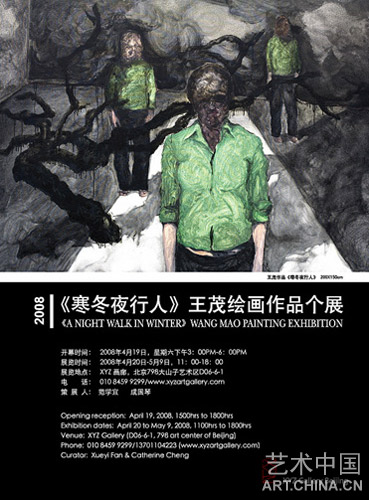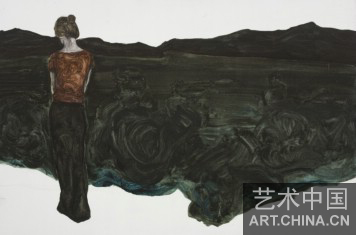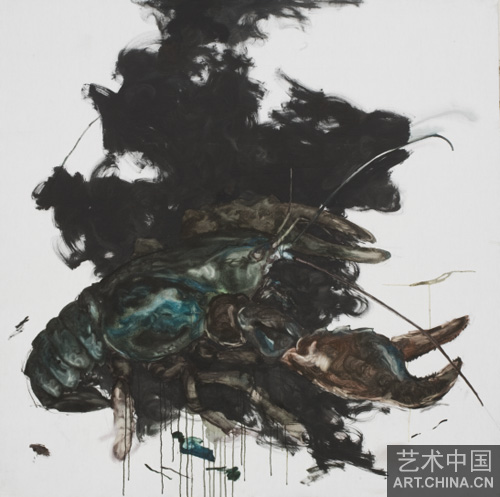
2008《寒冬夜行人》王茂繪畫作品個展
開幕時間:2008年4月19日,星期六下午3:00PM-6:00PM
展覽時間:2008年4月20日-5月9日,11:00-18:00
展覽地點:XYZ 畫廊,北京798大山子藝術區D06-6-1
電話:010 8459 9299/www.xyzartgallery.com
策展人:范學宜 成國琴
虛妄中前行——王茂繪畫有感
文:劉佳
王茂不像“80”一代人,不僅僅因為他篤信佛教,研習禪宗。沉穩、謙和的氣質使他在年輕一代中尤為另類,但這並不意味著他沒有年輕人的激烈、憤慨、徬徨、無助與追問,王茂説:“我只是去感受和表達一些別人都感受到的東西。”但是他將這種對生活強烈的訴求以深度思考的形式轉化成一種內斂、厚重與執著,所以在這個利益與慾望極端擴大化的時代裏,王茂就像一個清凈、悲憫的行者。
王茂的“佛系列”是他用“線”的代表,其對形象的捆綁、破壞,與賈克梅蒂對物象的探究、消解有共通的意味。王茂説他是在尋求“禪宗”中“似是而非”的禪理,但現在仍然太“是”了。這樣的思辨被他深深地混合在自己的藝術表現形式和內質之中。
一位參佛的朋友看過王茂的畫後説,能感覺到一種苦澀。王茂正是將苦澀作為一種修行,就像魯迅所説,直面慘澹的人生,這是他選擇面對生活的視角。看王茂的畫,觀者也會隨他進入“他者”的角度,“闖入”別人的片段生活中,在凝重的色調營造出的超現實氛圍裏與畫中人産生強烈的情感共振。畢業于中戲的王茂,自然地在作品中融入了豐富的敘事性與觀看感,而在這些略微荒誕、疏離、陰鬱的情境繪畫背後,我們感受到的是對人性複雜的描述與追問。《寒冬夜行人》是王茂喜歡的義大利作家卡爾維諾的小説,文學性與電影語言無形地灌注于王茂的思維形態與視覺取向中。在一幅以此命名的作品裏,人同影子一般地迷失在虛妄中,無望的氤氳在意念中升騰。王茂説自己以後可能畫人會越來越少,因為他不太喜歡人,他認為這個世界本可以不是這樣,是人造成了這般混沌的面貌,其實完全可以不必如此,不知道他筆下那些混沌狀態下的人是否也同樣這樣想。
失望的王茂在小動物的身上找到了出口,他畫的犀牛、蜜蜂、小雞、魚、龍蝦……尺幅很大,似有神性的附體,成為溝通混沌現實與天真、單純的使者,從脆弱、微觀的生命體中尋找到了久違的自在與舒適。王茂一直在找尋一個自己想要的世界,那不單單是一個具體的烏托邦式的遐想,更是一種深植內心的寧靜釋然。這種來自精神層面的暗示使他的視覺形象表現出了巨大的張力,這張力的源頭不是痛苦與鞭笞,而是源自東方哲學深厚的精髓造詣。像極了“古人”的王茂以極為當代的手法和青春的驛動闡釋了處於當下的中國傳統人文精神,在浮華、短促的時代堅守一份執著與淡然。
青年藝術家——王茂簡歷:
1980 生於中國湖北
2000-2004 就讀于中央戲劇學院舞美係本科
2004-2007 就讀于中央戲劇學院舞美係碩士
2007 王茂作品個展,北京798藝術區長征空間
2008 北京XYZ畫廊《筆墨的浪漫》
《寒冬夜行人》王茂作品個展,北京798藝術區XYZ畫廊
現居北京,自由藝術家

A Night Walk in Winter Series 2
200X150cm
[專稿] 王茂繪畫作品個展
2008《A NIGHT WALK IN WINTER》WANG MAO PAINTING EXHIBITION
Opening reception: April 19, 2008, 1500hrs to 1800hrs
Exhibition dates: April 20 to May 9, 2008, 1100hrs to 1800hrs
Venue: XYZ Gallery (D06-6-1, 798 art center of Beijing)
Phone: 010 8459 9299/13701104223 (www.xyzartgallery.com)
Curator: Xueyi Fan & Catherine Cheng
A World of Dark and Desperate Beauty:
Wang Mao Creates Drama on Canvas
By C. M. Voskuil, Ph.D.
I always feel a bit of trepidation when asked to review the works of a new artist. One must view art with an open mind and critical eye. I must honestly describe what I see, whether good, bad, or something in between. Yet, if disappointed, I must state clearly and perhaps harshly the shortcomings of the work as I see it – leading to disappointment and perhaps shattered hopes for those involved. Fortunate I feel, then, when I find myself in the presence of art that is truly what art should be. I feel relieved, and in a few rare cases, inspired. Such was my experience during my visit to the studio of the young and rising painter Wang Mao.
Wang, at 28 years of age, is a quiet and unassuming person – humble and serious in a way that few artists are today. His background has provided a fertile soil for the cultivation of creativity.
As a young boy, Wang’s parents were part of an opera troupe, thus he grew up surrounded by drama: elaborate sets and costumes, stirring music, and thrilling stories. When he decided to undertake further studies in the arts, he was accepted as a student at the prestigious Central Academy of Theatre in Beijing. There, he chose to focus his varied talents on painting. Today, he lives in a spacious apartment with sparse furnishings and cement floors in the outskirts of Beijing – in one of those sprawling, massive apartment cities that defy individuality and spit in the face of nature. The most notable aspect of his flat is a large floor to ceiling window that admits an abundance of natural light. As a result, it is an ideal ‘garret’ for this serious artist.
Here Wang can spread out, focus, and make use of the solitude and light he needs to paint. As for inspiration – well, that he seems to find in a place deep inside of himself. While many artists today are involved in creating a ‘cult of personality’ instead of producing art that is profound and accomplished, Mr. Wang is the antithesis of such ‘artists’. He said very little as he presented his works to me, letting the art speak for itself.
Although his immediate surroundings are bland, his inner world is what one sees on the canvasses.
It is a world of dark and disquieting beauty – reflective of the drama and depth of emotion that he has experienced during his own young life, and mixed with the elements of a vibrant and cultured imagination. Wang claims that his artistic influences range from the Chinese ink wash artist Ba Da to the disturbing modernist painter Francis Bacon, and certainly these are evident. One can also see in his works traces of the styles and techniques of some of the European romantic painters, as well as impressionists such as Cezanne and Sisley, and Pre-Raphaelites such as Dante Gabriel Rossetti. But there is also something completely unique and stirring about Wang’s paintings – something that is his alone.
This distinctive quality is no doubt the result of his excellent training and unique experience.
Wang is a contemporary Chinese artist with exceptional technical skills whose works exhibit a penchant for the desperate and the dramatic, as well as a deep reverence for the natural world. It is in this that his ties to Romanticism seem most evident. Take, for example, his series of animal and insect paintings. These large scale works show a scholar’s awareness of the biological characteristics of the subjects: a rhino, a frog, a chick, a bee, a lobster, a fish. Yet they are alive with movement – each seems frozen in a split-second’s action, yet still appears to be in motion. The scale (the canvasses are larger than most humans) brings each into almost lifelike proximity to the viewer, and particularly the smaller creatures make one feel miniscule by comparison. This is the worship of nature in its truest form; the depiction of the animal world in a way that inspires a thrilling awe for its beauty and dignity.
The same respect and dignity is also applied to Wang’s human subjects. Like the breathtaking Bee and remarkable Chick, the work entitled Baby conveys to the viewer a sense of the awesome beauty of the human child, a being as dignified and worthy of wonder as are the creatures of the animal world. The baby also seems simultaneously frozen in time and in motion, allowing us the opportunity to examine the spark of life so evident in the very small and the very hopeful.
Indeed, nothing says ‘hope’ for the future of humanity more than a baby like this one, chubby and smooth skinned, ready to burst forth into the world, yet not fully knowable, like a question mark, surrounded by a sense of mystery.
The same reverence for the mystery of the human experience can be seen in Wang’s other works such as By the Lake, Something Related to True Love, Long Live Love, and When Day Comes. In each, human beings are shown engulfed in a darkness of pain, sadness, ambivalence, loneliness, and sheer want.
Yet each is depicted with a dignity and a profound appreciation of human suffering that can only be described as beautiful. In addition, Wang’s brushwork reveals sweeping curves that stir the emotions and the imagination of the viewer. Swirling amidst the pain and despair is this dark, billowing substance – movement itself - and it brings an added exhilaration to the darkness, as if a storm or perhaps a clearing wind were blowing in. The churning brushwork evokes hope, even in the darkest of situations. It evokes the force of life, denotes the impending arrival of change, and reminds us of the unrelenting passage of time which brings something new, be it peace, drama, or some variation of these, to us all.
Wang’s paintings are a breath of fresh air in the contemporary art world – a breath of air that carries the deep and satisfying aroma of the past, the intoxicating perfume of the Romantic and the exotic, and the fresh, unique scent of change, like that of an impending spring thunderstorm. You should experience its enchantment for yourself.
BIO OF WANG MAO
1980 Born in Hubei Province of China
2000 Graduate from Stage Art Department of Central Academy of Theatre
2004 Master Degree of Stage Art Department of Central Academy of Theatre
2007 B.C- Octopus Solo Exhibition at Long March Space Beijing
2008 ROMANTIC BRUSH INK Group Exhibition at XYZ Gallery Beijing
2008 A NIGHT WALK IN WINTER WANG MAO Painting Exhibition at XYZ Gallery Beijing
Now resides in Beijing as an independent artist

Large Animal Series_Shrimp
160X160cm
Oil On canvas
|

